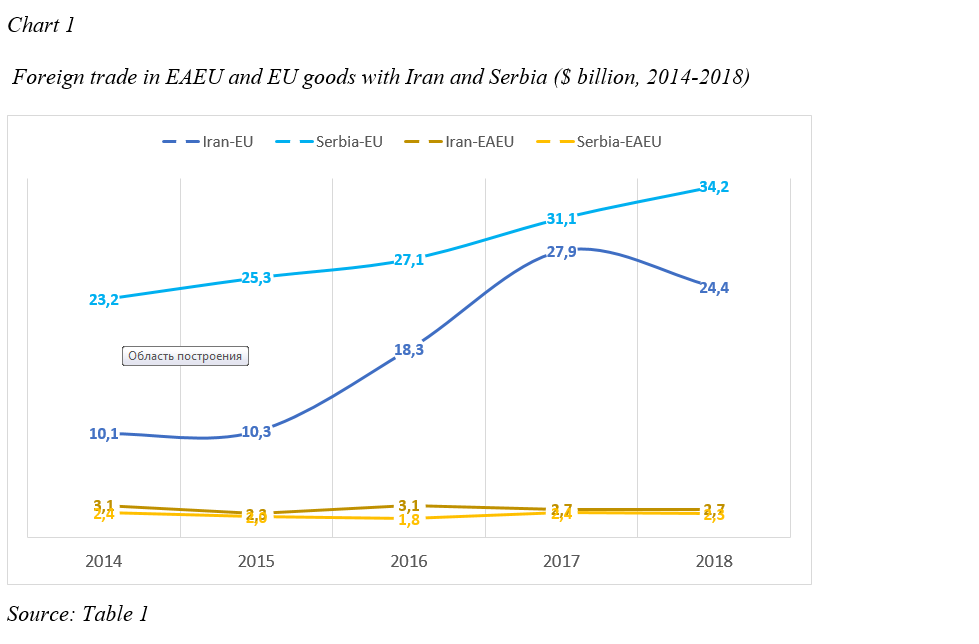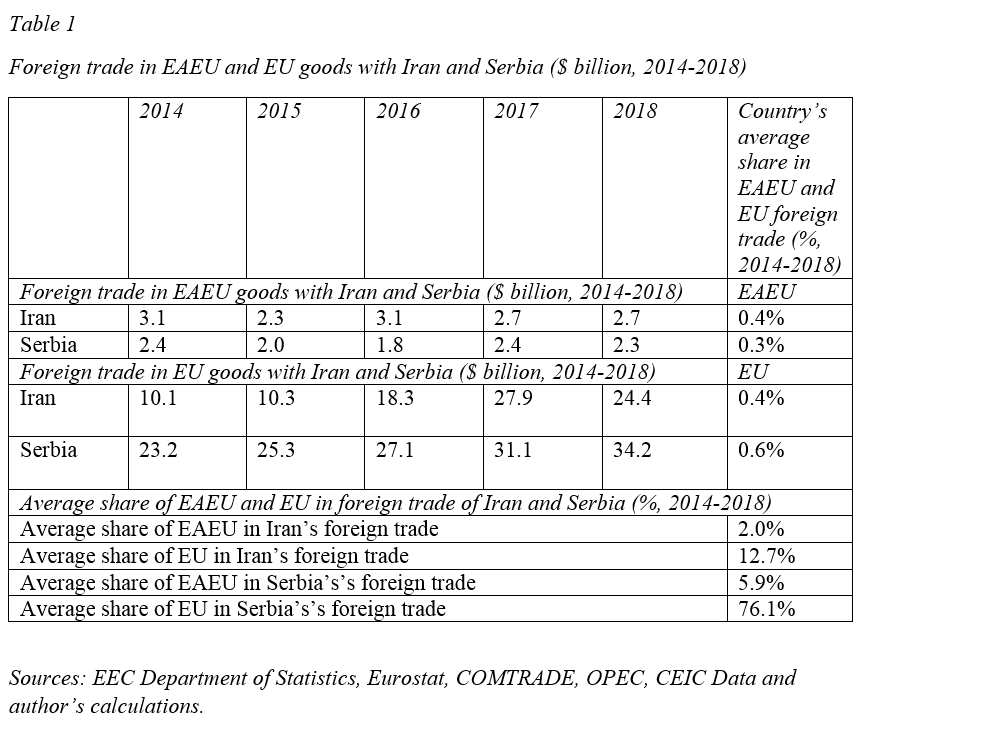On October 25 in Moscow, prime ministers of the Eurasian Economic Union (EAEU) member states, Chairman of the Eurasian Economic Commission (EEC) Tigran Sargsyan and Prime Minister of Serbia Ana Brnabic signed a Free Trade Agreement between Serbia and the EAEU. On October 27, a “temporary” free trade zone was launched between Iran and the EAEU.
The rise of Eurasia?
Serbia’s decision to conclude a free trade zone agreement with the Eurasian Economic Union was bad news for the European Commission, which had warned Serbia over making that decision several times. There are several reasons for Europe’s grudge. And given that Serbia accounts for less than 1 percent of the EU’s foreign trade (Table 1) , they are obviously geopolitical.
Firstly, Brussels has always been uncomfortable when it comes to the special friendship between Moscow and Belgrade, as they have been counting on Belgrade’s “gradual alignment with the common EU foreign and defense policies” as part of European integration. However, this naughty junior partner declined to join the European sanctions against the “eastern aggressor,” and worse still, decided to sign a new preferential trade deal with that aggressor.
Secondly, on the day when it is supposed to become a member of the EU, which is formally slated for the year 2025, Serbia will be obliged to cancel all its previous bilateral trade agreements with any third parties. However, there is no real guarantee that this day will ever really come, whether it be 2025 or some other year. Serbia is unlikely to have thrown aside the lessons it learned from its neighbors Northern Macedonia and Albania and their experience. Both these countries have been striving to become part of the European family for the last five and 10 years, respectively, only to get their accession vetoed from the European Council just last week.

 To be fair, I must say that both Serbia and Iran account for only a small share in the foreign trade structure of the EAEU: 0.4 percent and 0.3 percent, respectively. Similarly, for these two countries, trade with the EU is far more important than that with the EAEU. The EU’s share in Serbia's foreign trade is 76.1 percent, while the EAEU only accounts for about 6 percent. Almost 13 percent of Iran’s foreign trade is with the EU, and only 2 percent with the EAEU. (Chart 1, Table 1)
To be fair, I must say that both Serbia and Iran account for only a small share in the foreign trade structure of the EAEU: 0.4 percent and 0.3 percent, respectively. Similarly, for these two countries, trade with the EU is far more important than that with the EAEU. The EU’s share in Serbia's foreign trade is 76.1 percent, while the EAEU only accounts for about 6 percent. Almost 13 percent of Iran’s foreign trade is with the EU, and only 2 percent with the EAEU. (Chart 1, Table 1)
Free trade 101
In theory, each party to a free trade deal has two goals. On the one hand, with zero or lower import duties we open new market niches for our manufacturers’ goods (greater demand). On the other hand, opening our market in the same way, we get less expensive and better products for domestic consumption (greater supply). According to David Ricardo’s theory, cumulative welfare should grow on both sides. At the same time, there is no need to open markets with each other symmetrically. In international practice, it is often done asymmetrically, in terms of time, when the parties are given phasing-in periods, as well as for individual product groups. This is the case with the EAEU’s free trade deals with Serbia and Iran.
In particular, tariff preferences will enable EAEU manufacturers to increase their exports of food, strong liquor, cigarettes, and a variety of industrial products such as components for motor vehicles, chemical fertilizers, and electronic equipment.
On the other hand, the agreement provides for a duty-free import of 99.5 percent of goods produced in Serbia into the EAEU. This means that a few years after the deal, Serbia’s exports to a common market of 184 million people can increase by another 15 percent or so above the agreement-free scenario.
Basically, the EAEU will open its market by reducing import duties for Serbian farm produce such as cheese, tobacco and local brandy (Rakia). At the same time, the EAEU will not extend trade preferences to poultry meat, sugar, fabrics, plus to a number of industrial goods including compressors and motor vehicles. According to experts, Russia will keep its protectionist policies to protect its auto industry from the possible competition of the Serbian Fiat.
As for Iran, given the unstable international situation, the unknown business environment and the overlapping economic structure, the EEC and the individual EAEU governments have for the time being decided to opt for an interim agreement “leading to the formation of a free trade zone” – a three-year trial version, one might say. It covers only half of the commodity range and does not extend preferences to goods like crude oil or refined products.
In exchange, the EAEU will receive preferences for the supply of meat and fat-foods, various sorts of confectionery and chocolate, as well as metals, cosmetics, and things like electronic and mechanical goods. In particular, the arrangement will benefit Eurasian producers of environmentally friendly halal produce, rolled steel and telecom equipment, which over the past three years have become the EAEU's main export products to the Iranian market.
In turn, the Iranian side will be provided with tariff preferences for an expanded list of food, primarily vegetables, fruit, dried fruit, as well as building materials, utensils, some non-ferrous metal products and, most importantly, the famous Persian rugs.
The EAEU-Serbia and EAEU-Iran free trade agreements provide for a number of other advantages in addition to the direct reduction of import duties. Firstly, neither Serbia nor Iran are members of the World Trade Organization (WTO), yet, under the deals, both agree to grant EAEU goods “basic” conditions based on the WTO rules, especially as regards applying protective measures, permission disputes and rules of origin. Thirdly, small Armenia should especially benefit from the access to the 83-million-strong Iranian market – it can become a transport and logistics hub on the North-South international transport corridor, and its Meghri Free Economic Zone, an interesting platform for the assembly of European, Eurasian and Iranian companies’ products with the subsequent foray into the latter two markets. Fourthly, transparent and preferential trade terms should contribute to stability on the markets, which naturally enhances the confidence of entrepreneurs, and consequently, creates a favorable environment for investments.
Incidentally, on October 25, the EAEU’s non-preferential agreement on economic and trade cooperation with China also became effective. Many experts have opposed Beijing's proposal to create a free trade zone with the EAEU, believing that Eurasian producers will not be able to compete with their Chinese counterparts. But why not give one another preferential terms for a short and asymmetric list of goods? They say, for example, that the Chinese are very fond of ice cream labeled “made in the EAEU.”




